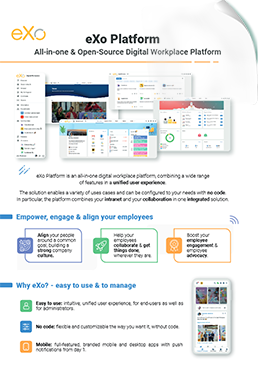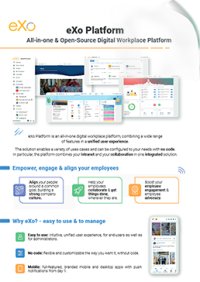Discover the new generation
company intranet
company intranet
In today’s busy workplace, companies need to connect employees quickly, cut down on noise, and keep things running smoothly. A modern intranet portal serves as a central place where teams can share updates, collaborate on projects, and get work done without all the confusion.

Unlike traditional intranets, modern intranet portals leverage AI, social features, and mobile accessibility to enhance productivity. Studies show that companies with well-structured intranets experience:
🔹 📈 25–35% Boost in Employee Productivity
AI-powered collaboration platforms and modern social intranets can increase productivity by 25–35%, especially in knowledge-intensive roles. These gains come from faster access to information, improved cross-team communication, and integrated workflows.
🔗 Source: McKinsey – The State of AI in 2024
🔹 📧 40–50% Reduction in Email Overload and Meeting Time
Companies using advanced collaboration tools (like Microsoft Viva, Slack, or integrated intranet suites) report a 40–50% reduction in internal emails and a marked decrease in unnecessary meetings—leading to more focused and efficient workdays.
🔗 Source: Forrester – Future of Work 2024
🔹 💡 30% Faster Knowledge Discovery with AI
By 2025, 60% of organizations will adopt AI-enhanced intranet features to automate knowledge management, cutting down search time by 30% and boosting operational efficiency.
🔗 Source: Gartner – Digital Workplace Trends 2024
🔹 🚀 59% Lower Turnover + 23% Higher Profitability
Organizations with highly engaged employees—empowered through connected digital experiences—see 59% lower turnover and 23% higher profitability. A modern intranet is key to building that engagement, especially in hybrid and remote-first workplaces.
🔗 Source: Gallup – Employee Engagement Trends 2024
But what exactly is an intranet portal? How does it benefit businesses? And with so many solutions available, how do you choose the right one?
This ultimate guide for 2025 will delve deep into the world of intranet portals, exploring their critical importance, key features, implementation strategies, and a detailed comparison of top solutions, with a focus on why eXo Platform stands out as the optimal choice for organizations aiming for a truly human and connected digital experience.
Put simply, an intranet portal is a private, secure network that serves as a central access point for company resources, tools, and communications. It works like a digital front door, giving each user a personalized hub where they can grab documents, launch apps, and tap into key resources without hunting around. Picture it as your firms own little corner of the web, built to smooth day-to-day work and keep folks in sync.
Unlike the public Internet, an intranet is restricted to employees, ensuring data security while improving internal collaboration.
Modern intranets go beyond basic document storage—they integrate:
According to a 2024 study by Gartner, 74% of high-growth companies use intranets to enhance employee engagement and operational efficiency.
While the core purpose remains the same, intranet portals have evolved into various types, each with a slightly different focus:
Let’s be honest—work can feel chaotic. Between endless emails, lost files, and the constant hunt for the latest policy update, employees waste precious time just trying to stay organized.
That’s where a company intranet portal comes in. Think of it as your digital HQ—a single place where teams communicate, share knowledge, and get work done without the clutter.
Intranets solve critical business challenges by streamlining communication, improving collaboration, and enhancing productivity. Here’s how:
How many times have you scrolled through a long email thread just to find a file or an answer? Intranets cut down email overload by keeping announcements, documents, and discussions in one central hub.
✅ Fact: Companies using intranets report a 30% reduction in internal emails, freeing up time for real work.
Ever wasted 20 minutes searching for a document buried in someone’s inbox or an old shared drive? An intranet organizes everything—policies, training materials, project files—so employees can find what they need in seconds.
✅ Study: Deloitte found that good knowledge management systems save employees 5+ hours a week.
When information is easy to find, people get more done. No more waiting for replies or digging through folders—just quick access to what they need.
✅ Research: McKinsey found that companies with strong internal communication are 20-25% more productive.
Intranets aren’t just about files—they help build culture. With features like employee recognition, news feeds, and team spaces, they keep everyone engaged, whether they’re in-office or remote.
✅ Stat: Gallup reports that engaged teams show 21% higher profitability.
An intranet portal serves as a powerful tool for modern organizations, offering numerous advantages that enhance productivity, communication, and employee satisfaction. Below is a detailed breakdown of its key benefits, followed by a concise comparison table for easy reference:
Acts as a single, authoritative source for company-related information, reducing confusion and ensuring consistency.
Facilitates efficient and transparent communication, from leadership announcements to peer discussions.
Provides shared workspaces, document co-creation, and project management tools for seamless teamwork.
Features like recognition programs, feedback channels, and social interactions foster a connected and motivated workforce.
Automates routine tasks (e.g., approvals) and provides easy access to forms, saving time and reducing errors.
Captures and organizes critical information in a searchable format, preventing knowledge silos.
Centralizes applications and offers self-service options, allowing IT teams to focus on strategic initiatives.
Protects sensitive data with controlled access and robust security features.
A dedicated onboarding section provides new employees with essential resources from day one.
Analytics track intranet usage, popular content, and engagement levels, enabling continuous improvement.
Employees can access the portal from anywhere, on any device, ensuring flexibility.
| Benefit | Impact |
| Centralized Information | No more scattered files—everything in one place. |
| Improved Collaboration | Teams work together in real time with shared tools. |
| Automated Workflows | Reduces manual processes (e.g., approvals, form submissions). |
| Employee Engagement | Newsfeeds, recognition tools, and surveys keep staff connected. |
| Mobile Accessibility | Access from anywhere, on any device. |
| Enhanced Security | Protects sensitive data with role-based access controls. |
| Efficient Onboarding | New hires get instant access to training and resources. |
| Knowledge Retention | Prevents information loss with organized, searchable archives. |
| Data Analytics | Tracks engagement and optimizes content for better usability. |
By implementing an intranet portal, organizations can significantly improve efficiency, collaboration, and employee satisfaction while reducing operational inefficiencies. 🚀
A truly effective intranet portal in 2025 is more than just a digital filing cabinet—it’s the central hub for communication, collaboration, and productivity in your organization. Whether you’re upgrading an old system or deploying a new one, here are the must-have features for a modern intranet:
A user-friendly CMS allows non-technical teams to publish news, blogs, policies, and FAQs without IT support. Think drag-and-drop editors and customizable templates.
Employees waste hours searching for files. A smart search function with filters, AI suggestions, and deep indexing (across documents, emails, and apps) solves this.
Modern intranets come with built-in tools that help people connect and work better together. These include:
Whether your team is in the office or on the move, they should be able to access the intranet anytime, anywhere. A mobile-friendly design or a dedicated app makes it easy to:
No more being tied to a desk — your digital workplace goes wherever your people do.
A good intranet should work smoothly with the tools your team already uses. That means it should easily connect to:
The goal? Less switching between apps and more time getting things done.
A great intranet feels tailor-made. With custom dashboards, employees see news, tasks, and tools that matter to their role.
AI also lends a hand by suggesting useful content — like reminding you of a policy you might need or surfacing documents related to your work.
It’s like having a smart assistant built into your digital workplace.
Keep your files organized, secure, and up to date. A modern intranet lets you:
No more messy folders or outdated files — everything’s in one place and always up to date.
Stay on top of work with built-in tools that help teams plan and deliver:
Everything your team needs to stay organized and aligned.
Make everyday tasks quick and easy by letting employees handle things themselves — no waiting needed.
They can:
It saves time for everyone and keeps things moving smoothly.
Understand how your intranet is being used and what’s working.
Track things like:
This helps you improve the experience and keep people engaged.
Keep your employee intranet safe and trustworthy with strong security measures.
This ensures your information stays private and secure.
Make work fun and motivating by celebrating achievements.
This boosts employee engagement and encourages everyone to do their best.
A modern employee intranet isn’t just about storing files—it’s about connecting people, streamlining workflows, and driving engagement. The best platforms combine ease of use, smart integrations, and analytics to create a true digital workplace.
Implementing an intranet portal is a strategic undertaking that requires careful planning and execution. Here’s a step-by-step guide:
Building an intranet can mean two things: building from scratch or implementing an out-of-the-box solution.
This involves designing, developing, and maintaining the intranet entirely in-house.
This involves purchasing and configuring a ready-made intranet platform from a vendor.
A powerful intranet is only effective if employees actually use it. Low adoption rates are a common challenge. Here’s how to boost engagement:
Picking the right intranet portal starts with asking the right questions:
These points help you find the best fit for your company.
Despite its higher learning curve and cost, eXo Platform outperforms competitors with:
🔹 AI-Driven Efficiency – Smart search reduces time wasted on document hunting.
🔹 Superior Collaboration – Combines social networking with project management.
🔹 Future-Proof Scalability – Grows with your business needs.
🔹 Outstanding Security – Enterprise-grade protection for sensitive data.
A Forrester study found that companies using eXo saw a 40% faster decision-making process due to improved knowledge sharing.
After a comprehensive exploration of intranet portals, their importance, key features, implementation, and a comparative analysis of leading solutions, eXo Platform emerges as the optimal solution for organizations looking to build a truly modern, engaging, and future-proof digital workplace in 2025.
While other platforms offer compelling features, eXo Platform’s unique blend of strengths positions it as a superior choice, especially for those who value flexibility, ownership, and a holistic approach to employee experience.
We touched on eXo Platform’s cons earlier: a smaller community compared to giants like Microsoft, and the potential need to replace some existing tools. But let’s be human about this.
Imagine you’re building your dream home. You could buy a pre-fabricated house, and it might be great. It’s quick, easy, and you know what you’re getting. But what if you want a kitchen specifically designed for your family’s cooking habits, or a quiet reading nook bathed in morning light, or walls that truly reflect your personality? That’s where building a custom home, or at least a highly customizable one, comes in.
eXo Platform is that custom-built home, but without the headache of building it completely from scratch. Yes, the community might not be as enormous as Microsoft’s, but the eXo community is vibrant, passionate, and incredibly supportive. It’s a community of innovators who are actively shaping the future of digital workplaces. You’re not just a number; you’re part of a movement that believes in open innovation and tailored solutions. This smaller, more focused community often translates to more direct and personalized support when you need it.
And the “need to replace some MS tools”? Think of it as an opportunity, not a limitation. It’s a chance to consolidate, simplify, and often, improve. Are you truly getting the most out of every single Microsoft tool, or are some of them just “there” because they came with the package? eXo Platform offers a chance to critically evaluate your digital tools and create a truly integrated, streamlined experience where every component serves a clear purpose within a unified platform. It’s about intentional design, not just accumulation.
In 2025, the digital workplace is about more than just efficiency; it’s about fostering a sense of belonging, empowering employees, and creating a vibrant, interconnected organizational ecosystem. While many platforms offer pieces of this puzzle, eXo Platform provides the comprehensive, flexible, and human-centric foundation to build a truly exceptional digital workplace. It’s about giving your employees a digital home where they feel connected, productive, and valued. And that, in an increasingly digital world, is truly invaluable.
Investing in the right intranet boosts productivity, engagement, and long-term success. Ready to transform your workplace? Explore eXo Platform today! 🚀

eXo Platform : The Open-Source
Digital Workplace Platform
Download the eXo Platform Datasheet and discover all the features and benefits


Download the eXo Platform Datasheet and discover all the features and benefits
You will find here Frequently Asked Questions about intranet portal with all the answers in one place.
intranet is a term used with abundance whenever the subject of internal communication and collaboration is brought up which makes defining it a bit challenging. In its simplest form, an intranet is an internal website for your organization. It is used mainly for top-down communication where employees can access corporate news, policies and announcements.
An intranet portal is a secure internal website where employees can access information, tools, and communication channels in one place.
A CMS intranet is a secure internal platform that allows employees to create, manage, and share content across the organization. Think of it as your company’s digital headquarters—where communication, collaboration, and information management come together in one place.
A CMS intranet helps businesses streamline communication, improve collaboration, and boost productivity across departments. It replaces scattered tools and email overload with a unified, structured digital workplace.
A well-designed and powerful CMS intranet can do wonders for your organization. It can:
Look for features like page builders, WYSIWYG editors, permissions, version control, search tools, and multilingual support. These features ensure your CMS intranet grows with your team and remains easy to use.
Key features include:
These features ensure your intranet is user-friendly, secure, and scalable as your company grows.
Different intranet portals serve different purposes. Key types include:
They help solve major challenges:
An intranet portal serves as a powerful tool for modern organizations, offering numerous advantages that enhance productivity, communication, and employee satisfaction. Below is a detailed breakdown of its key benefits, followed by a concise comparison table for easy reference:
A truly effective intranet portal in 2025 is more than just a digital filing cabinet—it’s the central hub for communication, collaboration, and productivity in your organization. Whether you’re upgrading an old system or deploying a new one, here are the must-have features for a modern intranet
Implementing an intranet portal is a strategic undertaking that requires careful planning and execution. Here’s a step-by-step guide:
Building an intranet portal can mean two things: building from scratch or implementing an out-of-the-box solution.
🔗 Find out a detailed comparison to build or buy an intranet portal
A powerful intranet portal is only effective if employees actually use it. Low adoption rates are a common challenge. Here’s how to boost engagement:
Here are some Tips to drive adoption:
( Your e-mail address will not be published)
I am a Digital Marketing specialist specialized in SEO at eXo Platform. Passionate about new technologies and Digital Marketing. With 10 years' experience, I support companies in their digital communication strategies and implement the tools necessary for their success. My approach combines the use of different traffic acquisition levers and an optimization of the user experience to convert visitors into customers. After various digital experiences in communication agencies as well as in B2B company, I have a wide range of skills and I am able to manage the digital marketing strategy of small and medium-sized companies.